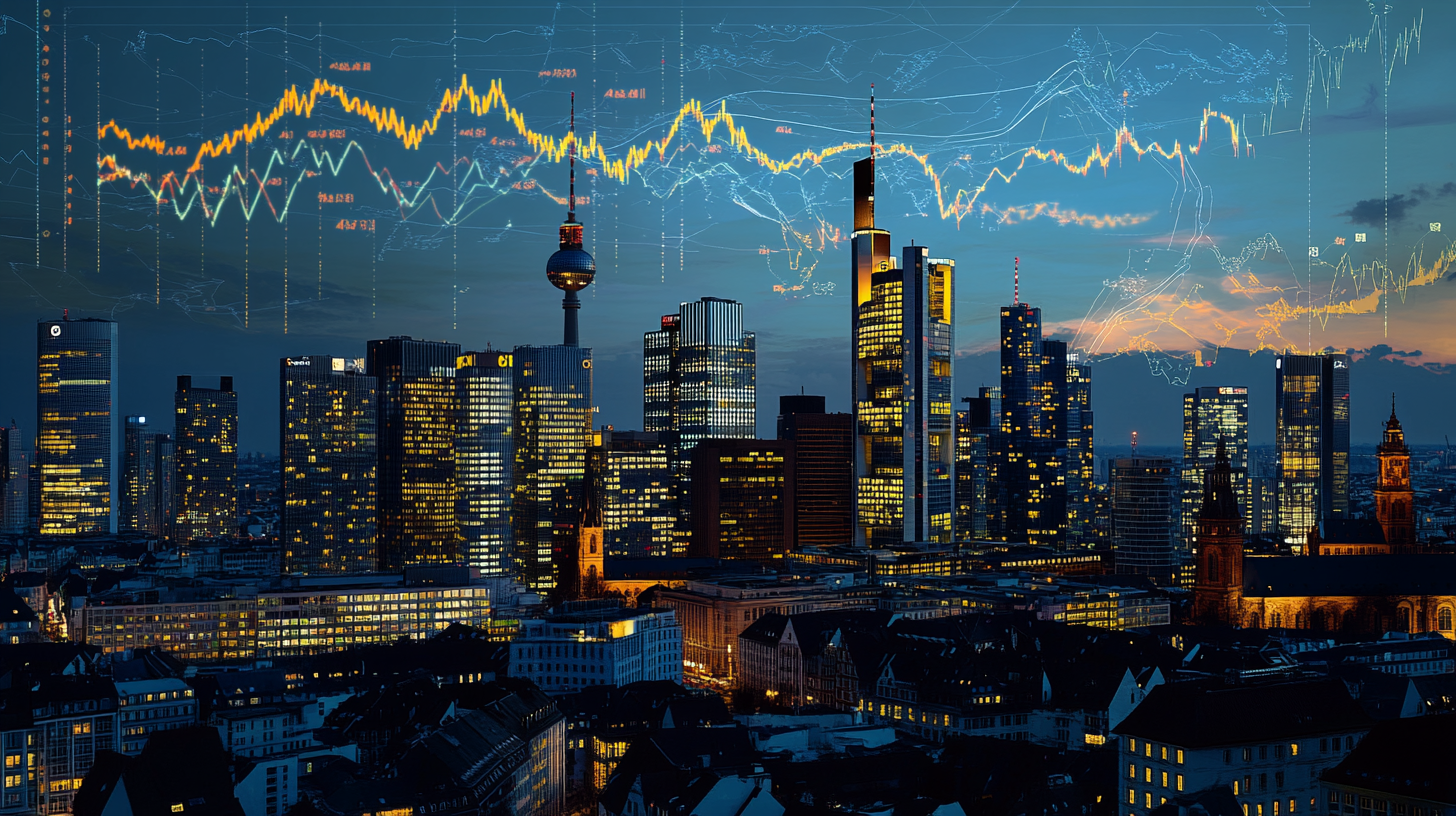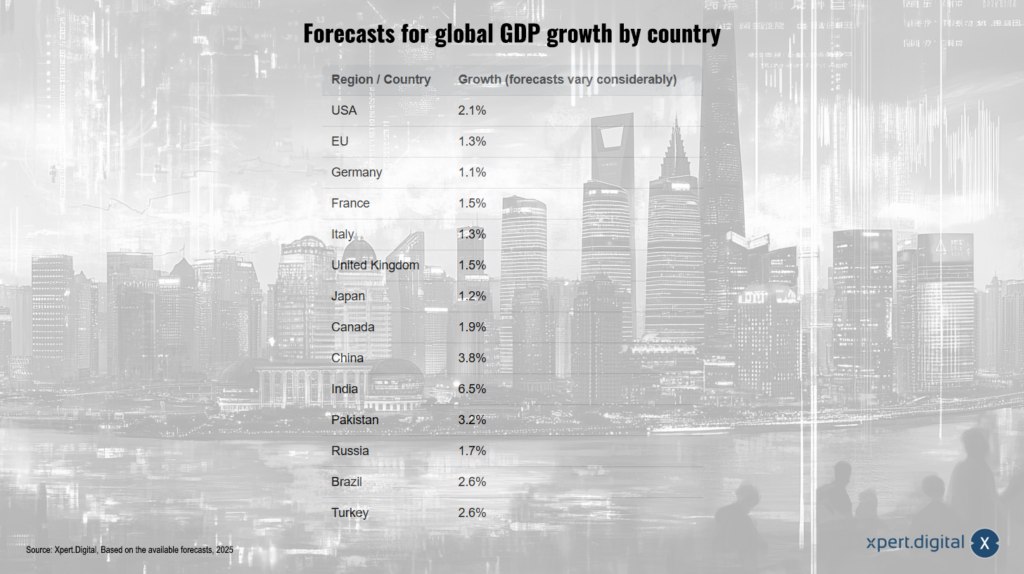Germany's economy in international comparison: recession, challenges and global perspectives in 2025
Xpert pre-release
Language selection 📢
Published on: January 9, 2025 / Update from: January 9, 2025 - Author: Konrad Wolfenstein

Germany's economy in international comparison: recession, challenges and global perspectives in 2025 - Image: Xpert.Digital
Emerging markets on the rise, Germany at a standstill: A global economic outlook
Energy prices, trade and structural change: Why Germany will lag behind in 2025
Germany will experience a phase of economic difficulties in 2025. Growth has been stagnating for two years after gross domestic product declined for two years in a row. The forecasts for 2025 are in a range that is very small and fluctuates between minimal and moderate plus. There are many reasons for this: structural weaknesses in key industries, increased energy prices, declining global trade and uncertainty about international supply chains. While emerging countries such as India and China continue to expect higher growth rates, Germany, along with some other European economies, remains in a comparatively weaker position. The following provides a comprehensive picture of the economic situation in various countries, highlighting the most significant challenges and opportunities, and showing how different economies are trying to achieve or exceed their economic goals in 2025.
“It is a time of great upheaval” – this is how the overall situation in many places in the global economy can be described. Technological innovations, geopolitical tensions and profound change processes towards digitalization and sustainability influence the economy. In this context, it becomes clear how individual countries are trying to respond with fiscal and monetary policy measures as well as structural reforms in order to support and modernize their economies in the long term.
1. The initial situation in Germany
Germany, long Europe's growth engine, will be in recession in 2025 after its GDP had already shrunk in previous years. The forecasts of the various institutes and committees vary between extremely low growth of 0.1% to 0.9%. The following challenges and causes are often discussed:
“Structural problems in German industry”
The German economy is struggling, among other things, with a strong dependence on the automotive industry. In addition, there is the slow expansion of future-oriented technologies such as artificial intelligence or renewable energies. Although large investments have been made in research and development in recent years, there are some delays in implementation.
“High energy prices”
The global energy crisis has hit Germany hard because the country is traditionally heavily dependent on energy imports. At the same time, political upheavals, increased CO2 prices and the accelerated phase-out of fossil fuels have made energy supplies more expensive. As a result, German industry suffers from competitive disadvantages, especially compared to locations with cheaper energy prices.
Suitable for:
“Weak export demand”
Germany's export strength has long been a guarantee of growth and prosperity. However, as trade tensions have increased worldwide and, for example, US economic policy - but also China - has shown protectionist tendencies, the German foreign trade model is suffering. The export engine is stalling and can no longer stimulate the domestic economy as it did in the past.
“Demographic development and shortage of skilled workers”
Another factor that is often highlighted is the rapidly aging population. Demographic change is increasing the shortage of skilled workers in almost all industries. Despite immigration, it is not easy to find enough qualified staff to keep innovative strength high.
Suitable for:
“ECB’s restrictive monetary policy”
In order to get inflation in the euro area under control, monetary policy was tightened. This makes loans more expensive for companies and consumers. The propensity to invest is decreasing, which has a negative impact on growth and employment.
All of these factors mean that, from the current perspective, Germany will be one of the slowest-growing industrialized countries in 2025. While there are countries in Europe with similar problems, there is a very heterogeneous development internationally.
2. USA: Solid growth and technology focus
The United States has known how to generate a surge in technological innovation. “We rely on artificial intelligence as a growth driver” is a common motto in industrial and government circles. This supports national productivity and creates new business areas. At the same time, fiscal policy measures, such as tax cuts, loosen the path for companies and investors. Although the USA was also confronted with inflation, it largely managed to keep the economy on an expansion path. Various economic stimulus programs have contributed to this, stabilizing the labor market and strengthening the purchasing power of many consumers.
However, the risk of trade conflicts remains. Protectionist tendencies and tariffs, especially on Chinese goods, are leading to tensions. The US government's stance on preventing certain technology transfers also impacts global supply chains. Nevertheless, economic growth is forecast for the USA that is significantly higher than that of Germany. In addition, the USA continues to benefit from its role as a reserve currency country, which gives it a lot of room for maneuver in financial policy.
Suitable for:
3. China: Between hunger for growth and challenges
China, which has been one of the fastest-growing economies for decades, remains a major global player in 2025. Although the growth rates have slowed somewhat compared to previous times, solid figures are still forecast that are significantly higher than those in Germany. A strong service sector and government guarantees, especially in high technology, drive the economy. Investments in artificial intelligence, infrastructure and production capacities remain high.
“The real estate crisis is weighing on the buying mood” – this sentence is often used when the temporarily cooled down real estate prices in China are discussed. While previous speculative bubbles led to rapid price increases, government measures and slower economic dynamics are now causing buyers to be more cautious. There is also a risk that ongoing US tariffs will dampen China's exports. A sustainable growth strategy therefore relies even more than before on domestic demand and the expansion of innovation-driven industries.
Suitable for:
- More than just numbers: What the current developments in China's economy really mean - What's ahead?
4. Japan: Old and new economic stimulus programs
Japan will remain in a transition phase in 2025. After years of efforts to combat deflation and revive economic growth, new economic stimulus programs are beginning to show success. A policy of negative interest rates was temporarily pursued, which was ended after an inflation target was reached. Nevertheless, domestic demand is rather subdued. The service sector, which contributes around 70% of gross domestic product, is an important pillar, but suffers from a shortage of skilled workers and rising wages.
In addition, the strength of the US dollar is slowing Japanese exports, although the yen was rather weak compared to other countries. Uncertainties caused by possible trade barriers between the USA and China, two of Japan's important trading partners, are also causing caution in Japanese companies' investment planning. “We need more quality instead of quantity” – this is a common demand in Japan, which expresses the fact that the country wants to concentrate more on high-tech developments, robotics and future sectors in order to remain competitive in the long term.
5. South Korea: Major exporter under pressure
South Korea's economy traditionally relies heavily on exports, particularly in the semiconductor industry. Demand for semiconductors will remain high in 2025, but global competition has intensified. Protectionist tendencies in the USA and China are affecting international goods flows and could affect South Korean companies. At the same time, South Korea is facing an aging population, dampening its long-term growth prospects.
The government is responding to this by investing in research and development in order to maintain the innovative strength of the South Korean economy. At the same time, new markets are being opened up and existing trade agreements are being expanded. “We cannot rely solely on our traditional strengths,” emphasize leading politicians in Seoul. Domestic demand is growing, but rather moderately, so export orientation remains a main topic in economic policy. Structural reforms aim to relieve the burden on the private sector and at the same time ensure social balance.
6. Singapore: trade hub with a liberal orientation
Singapore, one of Asia's most important financial and trading centers, continues to rely on open markets, an investment-friendly climate and macroeconomic stability. The government is making targeted investments in education and innovation to secure the city-state's competitive advantage. At the same time, geopolitical tensions pose a challenge. The trade conflict between the US and China, the world's two largest economic powers, may affect Singapore's role as a middleman.
Nevertheless, the outlook for Singapore remains positive. “Our diversification strategy is paying off,” is what government officials often say. This means that Singapore is not just relying on a single industry or large trading partner, but is trying to position itself more broadly. Service sectors such as finance, logistics and tourism are recovering as the global economy regains some momentum. Rising real wages support consumption and leave the growth forecasts in the solid midfield.
7. India: growth giant with potential and problems
India will be characterized by particularly high growth rates in 2025. Economic growth is estimated to be well above the global average. The reasons for this are manifold: a rapidly growing population, large-scale infrastructure investments, a young and dynamic IT and services industry, and a government strategy that combines deregulation and state support programs.
“Digitalization as the key to success” – you often hear this formula in India. With inexpensive smartphones and rapidly expanding internet access, millions of people have gone online, opening up new markets for e-commerce, fintech and other digital business models. At the same time, inflation remains a challenge as rising food prices can slow consumption in parts of the population. Sustainable integration of all sections of the population into the economic recovery and modernization of agriculture remain on the agenda. But the momentum for reform and innovation in India is unbroken, meaning the country is optimistic about the future.
Suitable for:
8. Pakistan: Fragile stabilization and a long way forward
Pakistan is moving towards economic stabilization but remains vulnerable to external shocks. The forecast growth is higher than in the recession countries, but significantly lower than in the growth stars. “We have to adjust several things,” is a common assessment. The national budget remains under pressure, despite the country receiving financial aid and debt relief agreements.
Although reform measures and the easing of currency and import restrictions are leading to a certain recovery, Pakistan still needs to convince investors and create the conditions for sustainable growth. More free trade agreements, improved infrastructure and incentives for the private sector were announced. Agriculture remains an important sector, but it needs to be modernized to become more productive. A young population is both an opportunity and a challenge: in order to integrate them into the labor market, more investment in education and training is needed.
9. The EU in general: coordination and differences
The European Union is struggling for growth and cohesion in 2025. While there are robust labor markets in many member countries, average growth rates are expected to be below those of many international competitors. The economic stimulus programs have partly ensured that the labor market in southern and eastern European countries is gaining momentum. However, inflation remains an issue in parts of the EU, which is why the European Central Bank is sticking to its relatively tight monetary policy.
“We are committed to joint structural reforms” is how the European direction is often described. The expansion of digital infrastructure, the green transformation and the elimination of trade barriers within the internal market play a central role. For some member states, the public debt burden remains high. The EU is trying to deal with this through coordinated fiscal policy. In addition, the services sector continues to be a strong growth engine, although the industry is struggling with competition problems in some regions. Strong exporting countries benefit from global trade, but have to adapt to increasing conflicts in the global economy.
Economic Outlook 2025: Global GDP growth forecasts by region and country
Based on the available forecasts for global GDP growth by country, the following picture can be drawn for 2025:
Global forecast
Global GDP growth is estimated at around 3.2% in 2025. The Council of Experts expects global growth of 2.6% for 2025.
Forecasts by region and country
The forecasts for individual countries sometimes differ considerably. Nevertheless, there is an overall trend towards economic recovery in 2025, the extent of which will be significantly influenced by various factors and the successful implementation of economic policy measures.
- USA: 2.1% growth
- Eurozone: 1.3% growth
- Germany: 1.1% growth
- France: 1.5% growth
- Italy: 1.3% growth
- United Kingdom: 1.5% growth
- Japan: 1.2% growth
- Canada: 1.9% growth
- China: 3.8% growth
- India: 6.5% growth
- Pakistan: 3.2% growth
- Russia: 1.7% growth
- Brazil: 2.6% growth
- Türkiye: 2.6% growth
Regional differences
Africa and Asia are expected to grow the fastest with growth rates of over 4%. For Europe, experts predict growth below the global average of the last ten years.
Factors for the forecasts
The forecasts take into account various factors such as the expected recovery of the global economy, the development of inflation, monetary policy decisions and geopolitical tensions. It should be noted that these forecasts are subject to uncertainty and may change due to unforeseen events.
Our recommendation: 🌍 Limitless reach 🔗 Networked 🌐 Multilingual 💪 Strong sales: 💡 Authentic with strategy 🚀 Innovation meets 🧠 Intuition
At a time when a company's digital presence determines its success, the challenge is how to make this presence authentic, individual and far-reaching. Xpert.Digital offers an innovative solution that positions itself as an intersection between an industry hub, a blog and a brand ambassador. It combines the advantages of communication and sales channels in a single platform and enables publication in 18 different languages. The cooperation with partner portals and the possibility of publishing articles on Google News and a press distribution list with around 8,000 journalists and readers maximize the reach and visibility of the content. This represents an essential factor in external sales & marketing (SMarketing).
More about it here:
Important economic sectors and export goods at a glance
The international comparisons show that there are different leading industries, sectors and export goods depending on the country:
"USA"
Traditionally, services, real estate, finance and healthcare play a key role. At the same time, oil, aircraft parts and fuel are exported. The US is also a leader in the technology sector, particularly in software, internet services and artificial intelligence.
"China"
As an enormous manufacturing hub, the country is one of the largest exporters of electronics, machinery and industrial intermediate products. In addition to the manufacturing industry, the service sector is also gaining enormous importance.
"Japan"
It is well known that automobile manufacturing, electronics and mechanical engineering shape the Japanese economy. In addition, the chemical industry is becoming increasingly important. Japanese exports are focused on high-tech products, while the country is also developing more care and health services due to its aging society.
"South Korea"
Electronics and especially semiconductors stand out here. The country is also strong in shipbuilding, the automobile and steel industries. The production of consumer electronics and digital devices plays a crucial role.
"Singapore"
The city-state combines financial services, chemicals, electronics and dynamic high-tech manufacturing with its established status as a global trade hub. Numerous multinational corporations have their Asian headquarters there.
"India"
A large part of the added value comes from agriculture, while industry and services are growing rapidly. In addition to IT and software services, important exports include textiles, petroleum products, diamonds, medicines, machinery and steel.
"Pakistan"
Agriculture and the textile industry are central pillars. In addition, the country has industries such as cement, steel, automobiles and food processing. Exports are often focused on textiles, leather goods and sporting goods.
“EU”
In Europe the economy is highly diversified. Germany, France and other countries export machinery, vehicles and chemical products. At the same time, the service sector continues to grow, particularly in tourism, finance, consulting and trade.
Economic policy measures in comparison
Faced with the challenges, governments have developed different strategies:
"Germany"
In addition to economic stimulus packages and infrastructure investments, there is a focus on promoting innovation and tax relief for companies and citizens. However, it is criticized that some funding programs are implemented too hesitantly and that bureaucratic hurdles deter potential investors.
"USA"
A mix of tax cuts, deregulation and infrastructure investments dominates here. Technological development, particularly in the area of artificial intelligence, is being further accelerated by government programs and private investors.
"China"
The state steers the economy through targeted investments in key industries while trying to avoid excessive debt. Structural change means, in particular, reducing dependence on simple exports and increasing innovative strength in the high-tech sector.
"Japan"
It combines monetary and fiscal policy stimulus with structural reforms to advance the stagnating economy. “Abenomics” has been a buzzword for this triad for years. However, success remains limited by demographic developments.
"South Korea"
Seoul is relying on economic stimulus packages, promoting innovation in the high-tech sector and trade agreements. The government is also focusing on solving structural problems in the labor market and strengthening the private sector.
"Singapore"
Openness to trade and capital has traditionally been a cornerstone of economic policy. This is complemented by investments in education, technology and innovation programs that ensure the city-state remains highly competitive.
"India"
Deregulation and an offensive towards digitalization are determining elements. There are also major infrastructure projects, such as the road network and energy supply, in order to better network the huge country. Financial incentives are created for certain industries to enable more production and exports.
"Pakistan"
There they are relying on privatization of state-owned companies and deregulation to attract investors. Strict fiscal management aims to improve the budget situation. Long-term programs are intended to increase export volumes and diversify the economy more.
“EU”
The European Union pursues a coordinated policy using common monetary and fiscal policies. Structural reforms in the member states are intended to increase competitiveness, and green and digital agendas also play a central role. In many cases the EU is dependent on compromises as it has to reconcile the interests of many different countries.
Additional aspects in 2025: sustainability, digitalization and global supply chains
Three megatrends that will affect practically all economies will be particularly influential in 2025:
1) “Sustainability and climate protection”
Climate change is being discussed more intensively in many countries. Environmental standards are being tightened and decarbonization is in full swing. “We need a green transformation” is what we hear around the world. In order to achieve the Paris climate goals, many countries are pushing ahead with the expansion of renewable energies. Industry also has to adapt, which causes high investment costs in some sectors.
2) “Digitization and Artificial Intelligence”
Whether in the industrial manufacturing process, in the service sector or in medicine – AI is finding its way into more and more sectors of the economy. Countries such as the USA, China and India are in a good position because they already have large digital companies and high investments. Europe is also increasing its efforts, but is sometimes falling behind. At the same time, opportunities are opening up for smaller economies, especially if they can react flexibly to innovation processes.
3) “Global supply chains and geopolitical tensions”
The pandemic years and the resulting focus on resilience have taught companies and governments that they should not rely too heavily on individual suppliers or supply regions. While the motto previously was “Just in Time”, the focus is now more on “Just in Case”, i.e. on warehousing and diversifying sources of supply. Geopolitical crises, for example possible conflicts in the South China Sea, in Eastern Europe or tensions between major powers, can lead to individual markets being sealed off.
Comparison of economic development
Comparing economic development in Germany, the USA, China, Japan, South Korea, Singapore, India, Pakistan and the EU reveals several fundamental insights:
- Firstly, there is a clear divergence between the growth rates of some industrialized countries and the dynamic development in certain emerging countries. While India, parts of Southeast Asia and China are showing some growth despite a slowdown, some established economies are struggling with stagnation or even recession.
- Secondly, the ongoing threat of trade conflicts, protectionism and geopolitical tensions leads to uncertainty. Export-oriented countries such as Germany, South Korea and China are particularly affected. Trade between the US and China remains tense. At the same time, some states will try to make themselves less dependent on global risks and promote more local value creation.
- Third, technological innovation remains a key driver of economic development. Countries that invest in digitalization, research and development and the expansion of their technological infrastructure have better long-term chances of increasing their productivity and competing on the global market. This not only affects high-tech nations such as the USA, Japan and South Korea, but increasingly also emerging countries such as India, which are rapidly expanding technology-intensive sectors.
- Fourth, there is a demographic problem in many countries, including Germany, Japan and South Korea. The aging of society and the decline in the working population are putting a strain on growth dynamics. Migration policy, targeted skilled worker programs and long-term family and education policy could be important building blocks to counteract this.
- Fifth, eyes are focused on structural change towards a more sustainable, climate-friendly economy. While investment programs in many countries - including the EU - are geared towards climate goals, this can cause upheavals in individual sectors. A successful transformation requires long-term planning, political stability and strategic use of capital and research.
“Germany must be courageous” – this is a frequently heard demand in panel discussions and in business associations when it comes to overcoming the recession and getting back to the top of the world. This means the consistent expansion of digital infrastructures, accelerated development of green technologies and more intensive cooperation with innovative partner countries. Germany also needs a modernization of administration, less bureaucracy, faster approval procedures and a culture that is more supportive of entrepreneurial risk. This is the only way to overcome the structural weaknesses and return to the growth path.
At the same time, closer cooperation is required in the EU. The introduction and consolidation of green industry support, a coordinated foreign and security policy, a joint approach to digitalization and cooperation on migration issues could help make Europe more competitive. The creation of a truly connected internal market for digital services and renewable energy can also be a decisive stimulus.
Looking at global markets
A look at the global markets shows: the global economy in 2025 is by no means homogeneous. Some countries are growing strongly, others are in recession, and still others are struggling to get out of it. However, almost everyone is faced with the task of reconciling technologies, sustainability and social stability. Tensions between the major powers, protectionist tendencies and regional conflicts create an overall uncertain situation. The continued high importance of energy prices and raw materials, combined with the trend towards diversification of supply chains, will also shape the global economy.
The question of whether Germany will emerge from its current phase of weakness will largely depend on how quickly and purposefully the political and economic actors act. Investments in future technologies, education and research efforts as well as an aggressive industrial and energy policy could turn the tide. At the same time, a forward-looking, global networking policy could open up new markets and encourage domestic companies to take more risks.
“Changes are inevitable, but they can be shaped, not just endured” – this thought aptly sums up the coming years in the global economy. Many countries, including the USA, India, South Korea and Singapore, have adapted their economic strategies and are increasingly focusing on innovation and opening up new markets. There is also a great awareness in China that after the phase of breathtaking growth, a differentiated policy is now required that reduces debt, promotes technology and strengthens domestic demand. Japan, which has been battling economic stagnation for decades, is also taking steps to maintain its competitiveness through new technologies and reforms. Pakistan is at the beginning of a long journey in which stabilization and liberalization must go hand in hand, while the EU seeks greater coordination and the implementation of joint projects.
Ultimately, the situation in 2025 will be characterized by both challenges and opportunities. Innovations such as AI, quantum computing, green technologies and biotechnology could not only help to renew old structures, but also create new business areas, create jobs and improve people's quality of life. The decisive factor will be how politics, companies and societies react to this. National unilateralism can bring short-term benefits, but there is a risk that too isolated policies will hinder global exchange and potentially dampen growth. Finding a balance between openness and protection, between competition and cooperation, is the big task.
From today's perspective, every country has its own path, its own history, its own strengths and weaknesses. But in a globalized world, the development of each country has an impact on the whole. If Germany overcomes its crisis and provides innovative impulses again, this could inspire suppliers in Poland, the Czech Republic or Italy, for example. If the USA and China defuse their trade conflicts, third countries will also benefit from smoother supply chains. If India continues on its path to becoming a growth champion, it could attract foreign companies and thereby trigger new global dynamics.
Suitable for:
This will not provide a homogeneous picture of the global economy in 2025
The global economy in 2025 will not offer a homogeneous picture, but will be a patchwork of different situations and strategies. Germany is in a recession that needs to be overcome with smart, future-oriented economic policy and structural reforms. Other countries are doing better, although they are also struggling with their own problems. “One world, many paths” – this is how the global economic reality could be summed up in a nutshell. Ultimately, it is clear that adaptability, innovation and a long-term vision will be crucial to mastering the economic challenges. The path to lasting prosperity leads through investments in education, research, digitalization, sustainable energy and social stability. If these tasks are tackled courageously, the prospects for Germany and the other affected countries can brighten significantly.
We are there for you - advice - planning - implementation - project management
☑️ SME support in strategy, consulting, planning and implementation
☑️ Creation or realignment of the digital strategy and digitalization
☑️ Expansion and optimization of international sales processes
☑️ Global & Digital B2B trading platforms
☑️ Pioneer Business Development
I would be happy to serve as your personal advisor.
You can contact me by filling out the contact form below or simply call me on +49 89 89 674 804 (Munich) .
I'm looking forward to our joint project.
Xpert.Digital - Konrad Wolfenstein
Xpert.Digital is a hub for industry with a focus on digitalization, mechanical engineering, logistics/intralogistics and photovoltaics.
With our 360° business development solution, we support well-known companies from new business to after sales.
Market intelligence, smarketing, marketing automation, content development, PR, mail campaigns, personalized social media and lead nurturing are part of our digital tools.
You can find out more at: www.xpert.digital - www.xpert.solar - www.xpert.plus



























